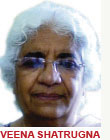Exclusive cereal-dependence
 The ICDS programme launched in the 1970s was based on the results of extensive surveys which identified rampant child under-nutrition in India. Using the weight-for-age and height-for-age criteria, only 10 per cent children under five could be classified normal. And 15-20 per cent were underweight even when they were short.
The ICDS programme launched in the 1970s was based on the results of extensive surveys which identified rampant child under-nutrition in India. Using the weight-for-age and height-for-age criteria, only 10 per cent children under five could be classified normal. And 15-20 per cent were underweight even when they were short.
The situation has not improved in the past 35 years despite juggling with classification. With a 500-600 calories (cal) deficit in energy intake, it is not surprising there is unimaginable hunger among Indian children. Over 70-80 per cent of the calories consumed by children are derived from cereals and some pulses. The intake of other protective foods such as eggs, milk, fruits and oil is minimal. The reasons for this nutrition emergency are many but the most important are undoubtedly poverty and inadequate diet.
A modified adult diet of cereals/ gruel in inadequate amounts serves as the only complementary food for children in poor households. Though the actual deficit in intake was around 500 cal, and about 10 gm of protein, nutritionists decided on a supplement of 300 cal and 10 gm of proteins when ICDS was launched.
The early menus under the scheme were based on a cereals, pulses, groundnut, oil, milk powder and sugar combination to fill the calorie gap; it was called the Hyderabad Mix. Deficits were not laid out in terms of food, but in terms of calories and proteins, assuming recipes would be adapted to regional tastes and translated into foods appropriate for children, like milk.
In the 1930s, W R Aykroyd, director of the Nutrition Research Laboratories in Coonoor, realized the importance of proteins, fats, vitamins and minerals for a child
